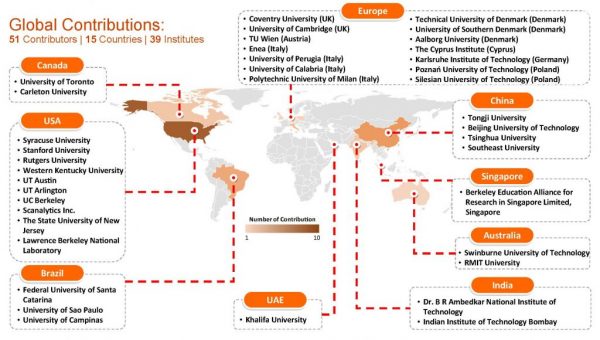There’s a new publicly accessible website from American Society of Heating, Refrigerating and Air-Conditioning Engineers (ASHRAE), ashraeobdatabase.com, that informs educators and practitioners like designers and energy modelers how people all over the world use buildings.
SyracuseCoE Associate Director and Mechanical and Aerospace Engineering Professor Bing Dong and several students have compiled research from 15 countries on how building occupants behave – more specifically, how they interact with building systems like windows, doors, light switches, thermostats and fans.

World map showing contributors to ASHRAE’s global occupant behavior database.
Why this matters: Even with good intentions to get outside more, we actually spend most of our lives indoors. As a result, the heating, ventilation and air-conditioning used in commercial buildings accounts for nearly 10% of global electric energy use. This will increase as the world electrifies to shift away from fossil-fuels.
The race is on to innovate for efficiency. Intelligent building technologies and retrofits are part of the solution. Occupant behavior is a crucial, but often overlooked component. Both buildings and people need to get smarter about energy use.
Industry organizations are steering best practices to reduce carbon footprint, but is it enough? The United States Green Building Council (USGBC) and ASHRAE have developed standards and guidelines to support sustainably upgrading building design and construction practices. Out of these efforts, processes like LEED Certification have been launched to promote energy-efficient buildings. However, these are mostly in developed countries. And, a recent study showed that LEED-certified buildings perform with only about 10% less energy.
Zoom In: There are many factors that influence energy consumption, including architectural design, engineering technologies, cultural background, occupant behavior and social equity. On closer inspection, researchers found there was not a performance gap, but an information gap. The building systems were not underperforming, but a lack of understanding about human-building interactions led to suboptimal operations and limited the development, testing and deploying new energy-efficient building technologies. More occupant behavior information is needed.
Why Create a Database?: Human behavior is complicated. In addition to privacy considerations and technology issues, there is the complex nature of how humans use buildings. Over 500 papers have been published but it is hard to find actionable conclusions for making buildings more efficient with so many variables.
Researchers need to undertake a bigger and more comprehensive effort to understand the nuances of how people behave in various building types, climates and nations. To influence energy-efficient building design and operation, performance monitoring, benchmarking, information visualization, better controls, fault detection and diagnostics are needed.
Zoom Out: The ASHRAE Global Occupant Behavior Database was built with inputs from 51 contributors, in 15 countries, from 39 institutions. Users can obtain information about different behavior types, cities, countries and building types from 10 different climate zones.
This comprehensive collection of building information from all over the world will inform building designers, energy modelers and consultants to accurately simulate building energy use and forecast building energy consumption.
The database was funded by ASHRAE (1883-RP), as part of the International Energy Agency’s Energy in Buildings and Communities Programme (IEA EBC), Annex 79 Project, with additional supports from Building Technologies Office of the United States Department of Energy, U.S. National Science Foundation (Award No. 1949372). The effort leveraged ASHRAE’s global society of 51,000+ members who advance research, write standards and publish continuing education for practitioners.
What’s Next: Occupant behavior testing continues around the world and in Syracuse. Professor Dong and Syracuse University student researchers are using the BEST Lab and other occupied spaces in the SyracuseCoE HQ building to conduct additional testing that will contribute to the growing pool of occupant behavior knowledge.
The database has been promoted to practitioners in the international community through presentations at industry conferences. Hopes are that the database will stimulate new ways of thinking and expand through contributions from global users, and additional funding will enable training and creating occupant behavior machine learning models. Ultimately, the information will inform ASHRAE standards and guidelines for buildings and contribute to energy efficient buildings by understanding how people interact with them.
Read more about The ASHRAE Global Occupant Behavior Database.
The ASHRAE Global Occupant Behavior Database was developed by Wei Mu, Yapan Liu and Bing Dong (Syracuse University, project lead), Tianzhen Hong (LBNL), Bjarne W. Olesen (Technical University of Denmark), Tom Lawrence (University of Georgia) and Zheng O’Neill (Texas A&M University) as part of the ASHRAE MTG.OBB research grant URP-1883.

